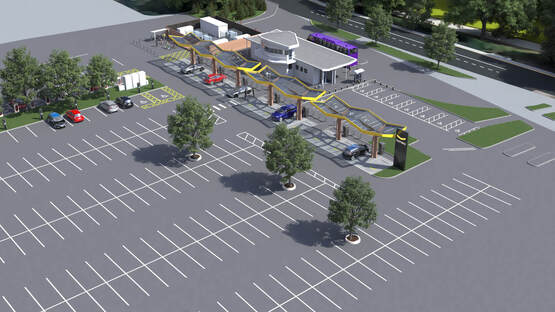Electric vehicles (EVs) are hitting the fast lane, and with them, the demand for efficient charging solutions is accelerating. In 2023, Bloomberg Green reported that the global EV market is expected to grow by 30%, underscoring the urgent need for robust urban EV infrastructure. One of the most exciting developments in this space is the emergence of fast-charging hubs, which are revolutionizing how we power our cars in city environments. This article will delve into how these hubs are transforming urban landscapes, enhancing EV adoption, and setting the stage for a greener future.
Fast-Charging Hubs: The Game Changer in Urban Mobility
What Are Fast-Charging Hubs?
Fast-charging hubs are strategically located charging stations equipped with high-speed chargers that can replenish an EV’s battery in a fraction of the time compared to traditional chargers. According to Electrek, these hubs can charge an EV up to 80% in just 20 to 30 minutes, compared to several hours with standard Level 2 chargers. This speed is crucial for urban dwellers who lack home charging facilities.
Benefits of Fast-Charging Hubs
- Time Efficiency: Ideal for city residents with busy schedules.
- Increased EV Adoption: By reducing charging times, these hubs eliminate one of the biggest barriers to EV ownership.
- Enhanced Grid Management: Advanced energy management systems help balance electricity demand.
How Fast-Charging Hubs Work
Fast-charging hubs employ Direct Current (DC) fast chargers, which bypass the vehicle’s onboard charger to deliver electricity directly to the battery. This technology, reported by TechCrunch, uses high power outputs ranging from 50kW to 350kW, significantly reducing charging time.
Key Technologies Used
- CHAdeMO and CCS (Combined Charging System): The most common standards for fast charging.
- Tesla Supercharger Network: Tesla’s proprietary charging technology, which can be accessed by other EVs at specific locations, thanks to recent partnerships.
- Dynamic Load Management: Ensures that the power is distributed efficiently among multiple charging vehicles.
The Impact on Urban Infrastructure
Boosting Urban EV Adoption
The installation of fast-charging hubs in cities is pivotal in encouraging more people to switch to electric vehicles. CleanTechnica notes that cities like London and Los Angeles have seen a 15% increase in EV registrations following the rollout of these hubs.
Urban Planning Considerations
- Strategic Location: Placing hubs in high-traffic areas like shopping centers and public transit hubs.
- Infrastructure Upgrades: Reinforcing the electrical grid to handle increased load.
- Incentives: Government subsidies and tax breaks for operators of charging hubs.
Environmental and Economic Benefits
Fast-charging hubs contribute to reduced urban air pollution and noise levels by promoting EV use. Additionally, they create economic opportunities through job creation in construction, maintenance, and operation.
Economic Impact
- Job Creation: According to Reuters Mobility, each new charging station can create up to 20 direct and indirect jobs.
- Investment Opportunities: Cities investing in fast-charging infrastructure attract businesses and boost local economies.
Practical Tips for Using Fast-Charging Hubs
How to Charge at a Fast-Charging Hub
Charging at a fast-charging hub is a straightforward process, but a few tips can enhance your experience:
- Plan Ahead: Use apps like PlugShare to locate nearby fast-charging hubs.
- Check Compatibility: Ensure your EV is compatible with the charging station’s technology.
- Monitor Charging: Keep an eye on your EV’s charging progress via your car’s app or the charging station display.
Where to Find Fast-Charging Hubs
Fast-charging hubs are increasingly found in urban centers worldwide. Some prominent locations include:
- USA: Tesla Supercharger stations are prevalent across the country, with significant coverage in California.
- Europe: Ionity and Fastned networks are expanding rapidly in countries like Germany, France, and the Netherlands.
- Asia: China boasts the world’s largest network of fast chargers, driven by companies like BYD and NIO.
What to Compare When Choosing a Charging Hub
When selecting a fast-charging hub, consider the following factors:
- Charging Speed: Ensure the hub supports your EV’s maximum charging rate.
- Cost: Compare pricing models as some operate on a per-minute basis while others charge per kWh.
- Accessibility: Consider the availability of amenities such as restrooms and food services.
Conclusion: Fast-Charging Hubs Pave the Way to a Cleaner Future
Fast-charging hubs are more than just a convenience; they are a cornerstone of the future urban EV infrastructure. By addressing key barriers to EV adoption and supporting sustainable urban living, these hubs are paving the way for a cleaner, more efficient future. As cities continue to embrace electric mobility, the expansion of these hubs will be crucial in achieving global sustainability goals.
Are you excited about the prospects of fast-charging hubs in your city? Join the conversation by sharing your thoughts and experiences in the comments below. As we look to the future, the integration of renewable energy sources with fast-charging technologies holds the promise of making our urban landscapes not only greener but also more resilient. Stay tuned for more updates on this electrifying evolution in urban infrastructure!

